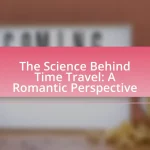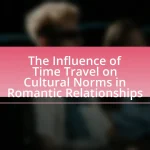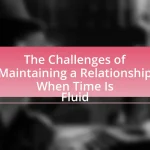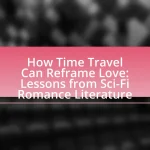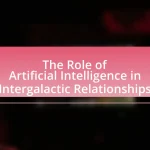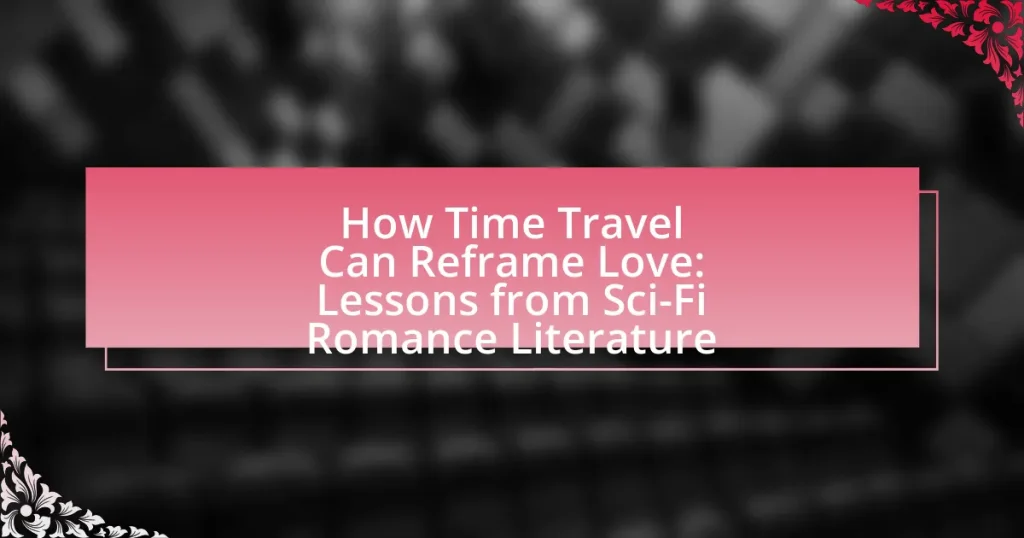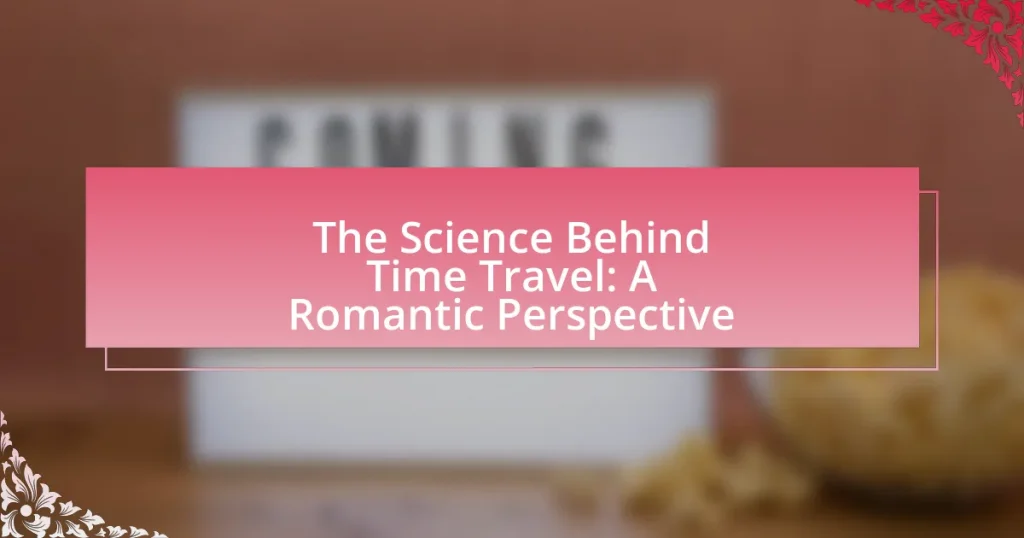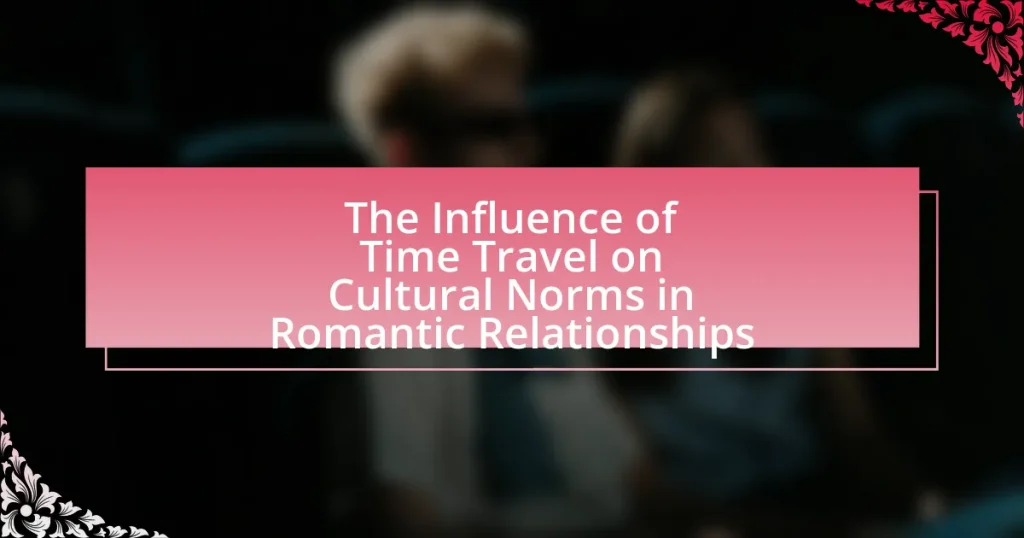The article examines how time travel in sci-fi romance literature reframes the concept of love, highlighting its complexities and emotional depth. It explores key themes such as the impact of time travel on relationships, the influence of technology, and the exploration of identity. Through examples from notable works like “The Time Traveler’s Wife” and “Outlander,” the article discusses how time travel narratives challenge traditional romantic tropes, present moral dilemmas, and reveal the emotional intricacies of love across different timelines. Additionally, it offers insights on how these narratives can enhance our understanding of love in contemporary relationships.
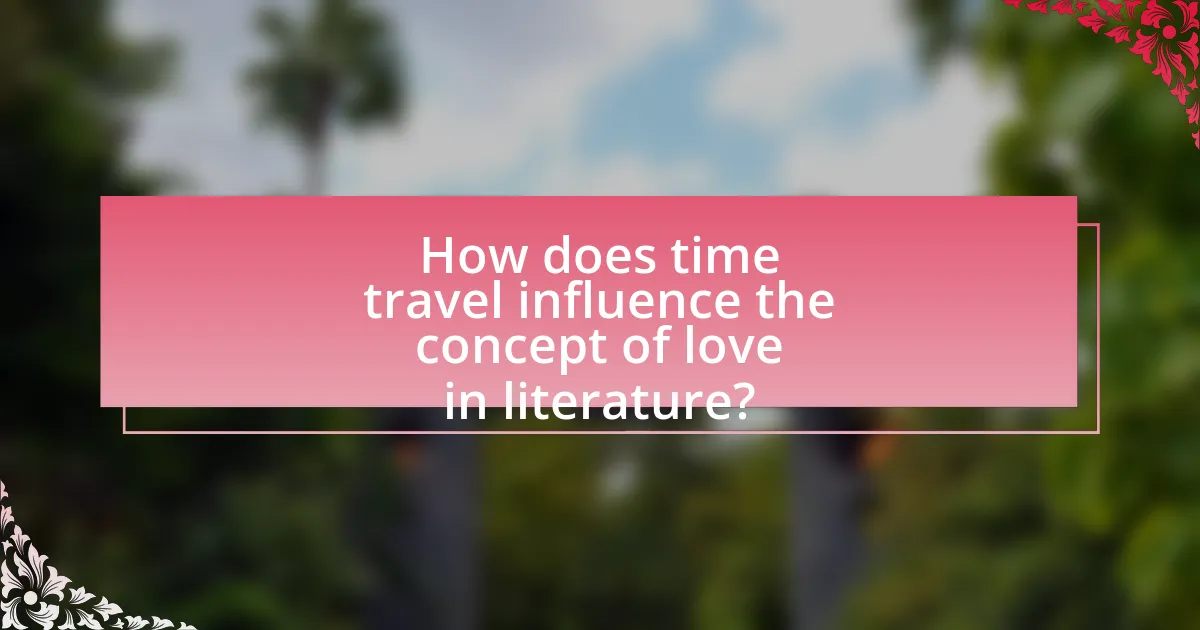
How does time travel influence the concept of love in literature?
Time travel significantly influences the concept of love in literature by allowing characters to explore relationships across different timelines, thereby challenging the traditional notions of fate and permanence. In works like “The Time Traveler’s Wife” by Audrey Niffenegger, the nonlinear narrative illustrates how time travel complicates love, as the protagonist experiences love in a fragmented manner, emphasizing the unpredictability and transient nature of relationships. This narrative device enables authors to examine themes of longing, loss, and the impact of time on emotional connections, as seen in “Outlander” by Diana Gabaldon, where time travel creates barriers and opportunities that reshape the characters’ love stories. Such explorations reveal that love can transcend time, yet is also subject to its constraints, ultimately enriching the emotional depth and complexity of romantic relationships in literature.
What are the key themes of love explored in sci-fi romance literature?
Key themes of love explored in sci-fi romance literature include the complexities of time travel, the impact of technology on relationships, and the exploration of identity and existence. Time travel often serves as a narrative device to examine how love can transcend temporal boundaries, allowing characters to confront past choices or future possibilities. Additionally, technology frequently alters the dynamics of love, raising questions about authenticity and emotional connection in a digital age. Furthermore, themes of identity are prevalent, as characters navigate their sense of self in relation to their partners, often leading to profound revelations about love’s nature. These themes are evident in works such as “The Time Traveler’s Wife” by Audrey Niffenegger, which illustrates the challenges of a love that defies time, and “Her” by Spike Jonze, which critiques the emotional implications of artificial intelligence in romantic relationships.
How do time travel narratives reshape traditional romantic tropes?
Time travel narratives reshape traditional romantic tropes by introducing complex temporal dynamics that challenge linear relationships and emotional connections. These narratives often allow characters to explore alternate timelines, leading to a deeper understanding of love’s multifaceted nature. For instance, in works like “The Time Traveler’s Wife” by Audrey Niffenegger, the non-linear progression of time forces characters to confront the implications of fate and choice in their relationship, thereby complicating the conventional notion of romantic destiny. This exploration of time not only enhances emotional depth but also prompts readers to reconsider the permanence of love, as characters navigate the consequences of their actions across different temporal realities.
What emotional complexities arise from time travel in love stories?
Emotional complexities in time travel love stories often include longing, regret, and the challenge of reconciling different timelines. Characters frequently experience a deep sense of nostalgia for lost moments, leading to emotional turmoil as they navigate relationships across time. For instance, the inability to change past events can create feelings of helplessness and sorrow, as seen in narratives where a character attempts to alter a tragic outcome but faces unforeseen consequences. Additionally, the juxtaposition of different eras can lead to conflicts in values and expectations, complicating the emotional landscape of the relationship. These complexities highlight the intricate interplay between love and time, revealing how temporal shifts can amplify both the joys and pains of romantic connections.
Why is sci-fi romance a unique lens for examining love?
Sci-fi romance serves as a unique lens for examining love because it explores relationships in contexts that challenge conventional norms and temporal boundaries. This genre allows for the exploration of love across different timelines, dimensions, and realities, which can reveal the complexities and nuances of human emotions in ways that traditional romance cannot. For instance, narratives involving time travel often highlight how choices and circumstances can alter relationships, as seen in works like “The Time Traveler’s Wife” by Audrey Niffenegger, where the unpredictability of time affects the protagonists’ bond. Such scenarios prompt readers to consider how love adapts, endures, or transforms under extraordinary conditions, thereby deepening the understanding of love’s resilience and multifaceted nature.
How does the speculative nature of sci-fi enhance romantic storytelling?
The speculative nature of sci-fi enhances romantic storytelling by allowing for the exploration of unconventional relationships and scenarios that challenge societal norms. In sci-fi, elements such as time travel, alternate realities, and advanced technology create unique contexts where love can transcend traditional boundaries, enabling narratives that examine the complexities of human emotions in extraordinary circumstances. For example, in works like “The Time Traveler’s Wife” by Audrey Niffenegger, the concept of time travel complicates the romantic relationship, illustrating how love can endure despite physical separation and temporal challenges. This imaginative framework not only captivates readers but also deepens the emotional resonance of romantic themes by presenting love as a force that can adapt and thrive in any situation.
What role does imagination play in the portrayal of love through time travel?
Imagination serves as a crucial mechanism in the portrayal of love through time travel, enabling the exploration of romantic possibilities that transcend temporal boundaries. This imaginative framework allows authors to create scenarios where love can defy the constraints of time, leading to unique narratives that examine the complexities of relationships across different eras. For instance, in works like “The Time Traveler’s Wife” by Audrey Niffenegger, the imaginative element of time travel facilitates a deep exploration of love’s endurance and challenges, illustrating how emotional connections can persist despite physical separations caused by time. Such narratives highlight the transformative power of love, suggesting that imagination not only enhances storytelling but also deepens the emotional resonance of romantic experiences across time.

What lessons can we learn about love from time travel narratives?
Time travel narratives teach us that love transcends time and space, emphasizing its enduring nature. These stories often illustrate that love can persist despite physical separation or temporal challenges, as seen in works like “The Time Traveler’s Wife” by Audrey Niffenegger, where the protagonists navigate the complexities of time apart yet remain emotionally connected. Additionally, time travel allows characters to confront their past mistakes, highlighting the importance of growth and forgiveness in love, as demonstrated in “About Time,” where the protagonist learns to appreciate everyday moments with his partner. Ultimately, these narratives reinforce that love is not only about the present but also about understanding and accepting the past to build a future together.
How do characters navigate love across different timelines?
Characters navigate love across different timelines by exploring the complexities of relationships that transcend temporal boundaries. In narratives involving time travel, characters often face challenges such as altered circumstances, differing life experiences, and the emotional weight of choices made in various timelines. For instance, in “The Time Traveler’s Wife” by Audrey Niffenegger, the protagonist’s involuntary time travel complicates his relationship with his wife, as they must adapt to the unpredictability of his absences and the impact of time on their love. This illustrates how time travel can serve as a narrative device to examine the resilience of love, the significance of timing, and the emotional consequences of choices across different temporal realities.
What challenges do time-traveling lovers face in their relationships?
Time-traveling lovers face significant challenges in their relationships, primarily due to the complexities of time manipulation and the resulting emotional and logistical issues. These challenges include the risk of temporal paradoxes, where actions taken in the past can alter the present or future, leading to confusion and potential loss of connection. Additionally, differing timelines can create emotional strain, as one partner may age or experience events differently than the other, resulting in mismatched life experiences and priorities.
For instance, in the narrative of “The Time Traveler’s Wife” by Audrey Niffenegger, the protagonist’s involuntary time travel creates a dynamic where the couple struggles with the unpredictability of their time together, highlighting the emotional toll of such a relationship. This illustrates how time travel can complicate love by introducing elements of uncertainty and separation that traditional relationships do not face.
How do these challenges reflect real-life relationship dynamics?
The challenges presented in sci-fi romance literature, particularly those involving time travel, reflect real-life relationship dynamics by illustrating the complexities of communication, trust, and emotional connection. For instance, characters often face misunderstandings due to time discrepancies, mirroring how miscommunication can lead to conflicts in actual relationships. Additionally, the element of time travel introduces themes of sacrifice and choice, which are prevalent in real-life partnerships where individuals must navigate personal desires against shared goals. These narratives highlight the importance of adaptability and resilience, as couples must confront external pressures and internal conflicts, akin to the challenges faced in everyday relationships.
What moral dilemmas are presented in time travel romance stories?
Time travel romance stories present several moral dilemmas, primarily centered around the consequences of altering the past and the ethical implications of relationships across different timelines. One significant dilemma involves the question of consent; characters may interact with their past selves or others in ways that raise issues about whether those individuals can truly consent to relationships when their futures are unknown. Additionally, the potential to change historical events poses ethical questions about the responsibility of the time traveler to preserve the timeline or intervene for personal gain. For instance, altering a tragic event to save a loved one can lead to unintended consequences that affect countless lives, highlighting the complexity of moral choices in time travel narratives. These dilemmas are often explored in works like “The Time Traveler’s Wife” by Audrey Niffenegger, where the protagonist’s time travel complicates his relationship and raises questions about fate and free will.
How do characters make choices that affect their love lives across time?
Characters make choices that significantly impact their love lives across time by altering pivotal moments in their relationships, which can lead to different outcomes. For instance, in time travel narratives, characters often face decisions that allow them to prevent heartbreak or rekindle lost love, demonstrating how their actions can reshape their romantic trajectories. A concrete example is found in the novel “The Time Traveler’s Wife” by Audrey Niffenegger, where the protagonist’s time-traveling ability leads to complex choices that affect his relationship with his wife, illustrating the profound consequences of seemingly small decisions over time.
What consequences arise from altering past or future relationships?
Altering past or future relationships can lead to significant consequences, including the creation of paradoxes, emotional distress, and altered timelines. For instance, changing a past relationship may result in the “butterfly effect,” where small changes lead to unforeseen and potentially negative outcomes in the present. This concept is illustrated in various sci-fi narratives, such as in the film “Back to the Future,” where altering events in the past jeopardizes the protagonist’s existence. Additionally, emotional repercussions can arise, as characters may grapple with the loss of relationships that were pivotal to their development. The exploration of these themes in literature highlights the complexities and risks associated with time travel and its impact on love and relationships.

How can we apply insights from sci-fi romance to our understanding of love today?
Insights from sci-fi romance can enhance our understanding of love today by illustrating the complexities of relationships across time and space. Sci-fi romance often explores themes such as the impact of time travel on emotional connections, showcasing how love can transcend temporal boundaries and evolve in response to different circumstances. For example, narratives like “The Time Traveler’s Wife” highlight how love persists despite challenges posed by time, emphasizing the importance of communication and adaptability in relationships. These stories provide a framework for understanding that love is not static; it can grow and change, reflecting the dynamic nature of human experiences and emotions.
What practical lessons can we take from time travel romances?
Time travel romances teach us the importance of seizing the moment and valuing relationships, as characters often face the consequences of time manipulation. These narratives illustrate that love transcends time and space, emphasizing the need to appreciate connections in the present. For instance, in “The Time Traveler’s Wife” by Audrey Niffenegger, the protagonist’s unpredictable time travel highlights the fragility of life and the urgency to cherish loved ones. This reinforces the lesson that relationships require effort and presence, as time is not guaranteed.
How can understanding time travel narratives improve our relationships?
Understanding time travel narratives can improve our relationships by providing unique perspectives on love, choice, and consequence. These narratives often explore themes of regret and redemption, illustrating how decisions impact relationships over time. For instance, stories like “The Time Traveler’s Wife” highlight the importance of communication and patience in love, as characters navigate the complexities of time apart. Such narratives encourage readers to reflect on their own relationships, fostering empathy and understanding by showcasing the emotional weight of choices and the value of shared experiences. This reflection can lead to stronger connections and improved conflict resolution in real-life relationships.
What strategies can we adopt to navigate love’s complexities in our lives?
To navigate love’s complexities in our lives, we can adopt strategies such as open communication, setting boundaries, and practicing empathy. Open communication allows partners to express their feelings and concerns, which is essential for understanding each other’s perspectives. Research indicates that couples who communicate effectively report higher relationship satisfaction. Setting boundaries helps individuals maintain their identity and personal space, reducing feelings of overwhelm and resentment. Practicing empathy enables partners to connect emotionally, fostering a deeper understanding of each other’s experiences and challenges. Studies show that empathy in relationships correlates with increased emotional intimacy and conflict resolution.
How can readers engage with sci-fi romance literature to enhance their perspective on love?
Readers can engage with sci-fi romance literature by exploring narratives that challenge conventional notions of love through time travel and alternate realities. This genre often presents unique scenarios where characters confront love across different timelines or dimensions, allowing readers to reflect on the fluidity and complexity of relationships. For instance, novels like “The Time Traveler’s Wife” illustrate how time manipulation affects emotional connections, prompting readers to consider how circumstances shape love. Engaging with such literature encourages critical thinking about the nature of love, as it often highlights themes of sacrifice, choice, and the impact of time on relationships.
What are some recommended sci-fi romance novels that explore these themes?
Some recommended sci-fi romance novels that explore themes of time travel and love include “The Time Traveler’s Wife” by Audrey Niffenegger, which intricately weaves the complexities of love across different timelines, and “Outlander” by Diana Gabaldon, where time travel significantly impacts romantic relationships. Additionally, “Kindred” by Octavia Butler examines the intersection of love and historical context through time travel, while “11/22/63” by Stephen King explores the implications of altering the past on personal relationships. These novels illustrate how time travel can reshape love and connection, providing unique perspectives on romance within the sci-fi genre.
How can discussions about these narratives foster deeper connections in real life?
Discussions about narratives in sci-fi romance literature can foster deeper connections in real life by encouraging individuals to explore complex emotional themes and shared experiences. Engaging with these narratives allows people to reflect on their own relationships, as they often highlight universal feelings such as love, loss, and the passage of time. For instance, a study published in the Journal of Social and Personal Relationships found that discussing fictional stories can enhance empathy and understanding among individuals, leading to stronger interpersonal bonds. By analyzing characters’ choices and emotional journeys, participants can relate these insights to their own lives, thereby deepening their connections with others.
